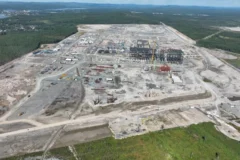After a brief July rebound, European construction activity retreated in August as infrastructure projects stalled and building construction weakened, though year-over-year comparisons suggest the sector has stabilized at subdued growth levels.
The European construction industry posted a marginal decline in August 2025, signaling a cooling period after modest gains the previous month, according to preliminary figures released by Eurostat, the European Union’s statistical office.
Seasonally adjusted construction production fell 0.1% in the euro area and 0.9% across the broader EU compared to July levels. This reverses the positive momentum seen in July, when the sector expanded 0.5% in the euro area and 0.9% in the EU.
On an annual basis, the picture remains subdued. Construction output in August 2025 edged up just 0.1% compared to the same month in 2024 for the euro area, while remaining flat across the EU—underscoring the sector’s struggle to gain meaningful traction.
Civil engineering drives monthly weakness
Breaking down the August figures by construction category reveals where the weakness concentrated. Civil engineering, which encompasses infrastructure projects such as roads, bridges, and utilities, bore the brunt of the decline, contracting 1.3% in the euro area and 2.5% in the EU on a monthly basis.
Building construction edged down 0.1% in the euro area while holding steady in the broader EU. Specialized construction activities, which include trades such as electrical work and plumbing, provided the only bright spot with a 0.1% uptick in the euro area, though this segment remained unchanged for the EU overall.
Sharp geographic divergence
The aggregate figures mask dramatic regional variation. Romania experienced a precipitous 26.2% monthly plunge in construction production, the steepest decline among member states. Hungary and Poland also posted significant contractions of 11.4% and 4.0%, respectively.
Conversely, Sweden led growth with a 4.2% monthly increase, followed by Czechia at 2.2% and Bulgaria at 1.4%, demonstrating that construction activity remains highly uneven across the continent.
Annual trends show sectoral shifts
The year-over-year comparison reveals a sectoral rebalancing underway in European construction. Building construction has emerged as the weakest segment, declining 3.8% in the euro area and 3.0% in the EU compared to August 2024, suggesting potential softness in residential and commercial real estate development.
Meanwhile, civil engineering showed resilience with annual growth of 2.6% in the euro area and 1.0% in the EU, indicating sustained investment in infrastructure projects. Specialized construction activities grew 2.0% across both regions, demonstrating steady demand for maintenance and renovation work.
On an annual basis, Slovenia registered the strongest performance with a remarkable 25.2% surge in construction output, followed by Czechia’s 17.0% gain and Slovakia’s 13.8% increase. These Central European markets appear to be benefiting from infrastructure investment and economic development initiatives.
At the other end of the spectrum, Hungary faced a 13.6% annual decline, while the Netherlands and Poland recorded decreases of 6.2% and 4.9%, respectively, highlighting persistent challenges in these major European construction markets.
The divergent trends across member states and construction segments suggest the European construction sector remains in a transitional phase, with infrastructure investment providing support even as building activity softens.






 Myrna Whitaker
Myrna Whitaker  Nils Lund
Nils Lund  Anna Broberg
Anna Broberg 